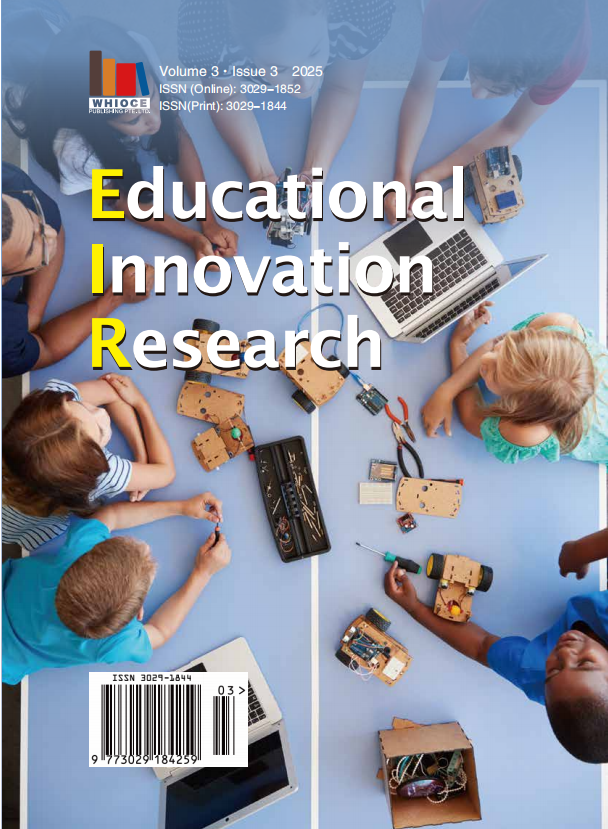Integrating Technology into Music Learning: A Tool for Enhancement, Not Substitution
DOI:
https://doi.org/10.18063/eir.v3i3.848Keywords:
Technology, Music education, PianoAbstract
The integration of technology into music education has significantly transformed the learning experience, particularly for beginner piano students. Technologies such as visual feedback systems and tactile measurement tools provide objective insights into performance, enabling learners to self-assess and improve technical accuracy. Digital platforms support flexible learning environments, allowing personalized practice schedules and fostering interactive engagement through online forums and multimedia resources. Blended learning models further enhance pedagogical effectiveness by combining traditional instruction with digital tools, promoting transparency and traceability in progress. However, the successful application of technology depends on educators’ critical selection and alignment with pedagogical goals. While technology offers valuable support, it cannot replace the irreplaceable role of teachers in guiding reflective and critical thinking processes.
References
Himonides E, 2019, Ave Verum Pentium: Singing, Recording, Archiving, and Analyzing within the Digital Domain, in The Oxford Handbook of Singing. Oxford University Press, Oxford.
Himonides E, 2012, The Misunderstanding of Music-Technology-Education: A Meta Perspective, in The Oxford Handbook of Music Education, Volume 2. Oxford University Press, Oxford.
Himonides E, 2017, Educators’ Roles and Professional Development, in The Oxford handbook of Technology and Music Education. Oxford University Press, Oxford.
Purves R, 2012, Technology and the Educator, in The Oxford Handbook of Music Education. Oxford University Press, Oxford, 457–475.
Himonides E, Purves R, 2010, The Role of Technology, thesis, University of London.
Savage J, 2012, Driving Forward Technology’s Imprint on Music Education, in The Oxford Handbook of Music Education, Volume 2. Oxford University Press, Oxford.
Crawford R, 2017, Rethinking Teaching and Learning Pedagogy for Education in the Twenty-first Century: Blended Learning in Music Education. Music Education Research, 19(2): 195–213.
Gorgoretti B, 2019, The Use of Technology in Music Education in North Cyprus According to Student Music Teachers. South African Journal of Education, 39(1): 1–10.
Hamond L, Himonides E, Welch G, 2020, The Nature of Feedback in Higher Education Studio-based Piano Learning and Teaching with the Use of Digital Technology. Journal of Music, Technology, and Education, 13(1): 33–56.
Hamond LF, Welch G, Himonides E, 2019, The Pedagogical Use of Visual Feedback for Enhancing Dynamics in Higher Education Piano Learning and Performance. Opus, 25(3): 581.
Banton LJ, 1995, The Role of Visual and Auditory Feedback during the Sight-reading of Music. Psychology of Music, 23(1): 3–16.
MacRitchie J, 2015, The Art and Science behind Piano Touch: A Review Connecting Multi-disciplinary Literature. Musicae Scientiae, 19(2): 171–190.
MacRitchie J, Bailey NJ, 2013, Efficient Tracking of Pianists’ Finger Movements. Journal of New Music Research, 42(1): 79–95.
Asahi S, Tamura S, Sugiyama Y, et al., 2018, Toward a High Performance Piano Practice Support System for Beginners. 2018 Asia-Pacific Signal and Information Processing Association Annual Summit and Conference (APSIPA ASC).
Marky K, WeiB A, Gedeon J, et al., 2020, Mastering Music Instruments through Technology in Solo Learning Sessions. arXiv preprint. https://doi.org/10.48550/arXiv.2012.13961
Marky K, WeiB A, Kosch T, 2021, Supporting Musical Practice Sessions Through HMD-Based Augmented Reality. arXiv preprint. https://doi.org/10.48550/arXiv.2101.00874
Bobbe T, Oppici L, Luneburg LM, et al., 2021, What Early User Involvement Could Look Like—Developing Technology Applications for Piano Teaching and Learning. Multimodal Technologies and Interaction, 5(7): 38.
Waddell G, Williamon A, 2019, Technology Use and Attitudes in Music Learning. Frontiers in ICT, 2019(6): 11.
Borota B, 2011, Motivation and Learning Results in Music Education Related to Blended Learning. Metodicki Obzori, 12(6): 49–59.
Rasheed RA, Kamsin A, Abdullah NA, 2020, Challenges in the Online Component of Blended Learning: A Systematic Review. Computers and Education, 2020(144): 103701.
Bouilheres F, Le LTVH, McDonald S, et al., 2020, Defining Student Learning Experience through Blended Learning. Education and Information Technologies, 25(4): 3049–3069.
Zaripovich KS, 2024, Pedagogical Requirements for a Modern Music Teacher and his Possibilities of using Technologies. Multidisciplinary Journal of Science and Technology, 4(2): 164–168.
Himonides E, 2018, The Misunderstanding of Music-technology Education: A Meta Perspective. Creativities, Technologies, and Media in Music Learning and Teaching: An Oxford Handbook of Music Education, 2018(5): 119.
Merrick B, 2024, Informed Teaching and Practice in Music Education: Exploring Music Technologies, Curriculum Design and Learning Environments in an Everchanging World, in Music, Technology, Innovation. Routledge, England, 113–131.
Seiter E, 2008, Practicing at Home: Computers, Pianos, and Cultural Capital. MacArthur Foundation Digital Media and Learning Initiative.
Zhang Y, Fen BW, Zhang C, 2024, A Systematic Review of Blended Learning Strategies and Outcomes in Music Education. Harmonia: Journal of Arts Research and Education, 24(2): 247–262.
Hrastinski S, 2019, What Do We Mean by Blended Learning? TechTrends, 63(5): 564–569.
Hartman RJ, Townsend MB, Jackson M, 2019, Educators’ Perceptions of Technology Integration into the Classroom: A Descriptive Case Study. Journal of Research in Innovative Teaching & Learning, 12(3): 236–249.
Niu Y, 2021, Penetration of Multimedia Technology in Piano Teaching and Performance Based on Complex Network. Mathematical Problems in Engineering, 2021(8872227): 12.
Chen Y, Zhang LC, Ding Y, et al., 2025, Multi-task Oriented Team Formation in Online Collaborative Learning. Expert Systems with Applications, 2025(259): 125289.
Mayhew E, Davies M, Millmore A, et al., 2020, The Impact of Audience Response Platform Mentimeter on the Student and Staff Learning Experience. Research in Learning Technology, 2020(28): 1–16.
Vallely K, Gibson P, 2018, Engaging Students on their Devices with Mentimeter. Compass: Journal of Learning and Teaching, 11(2): 1–6.
Holland D, Chapman D, 2019, Introducing New Audiences to Sound-Based Music through Creative Engagement. Organised Sound: An International Journal of Music Technology, 24(3): 240–251.
Namyssova G, Tussupbekova G, Helmer J, et al., 2019, Challenges and Benefits of Blended Learning in Higher Education. International Journal of Technology in Education, 2(1): 22–31.
Schumacher EF, 2004, Intermediate Technology. 1975: ACTION, International Operations, Planning Group.
Cain T, 2004, Theory, Technology and the Music Curriculum. British Journal of Music Education, 21(2): 215–221.
Tung BT, Schnieders D, 2018, Pianow—Piano Self-learning Assistant in Mixed Reality, thesis, The University of Hong Kong.

